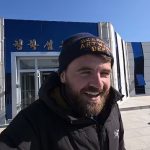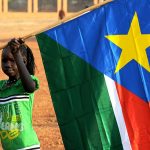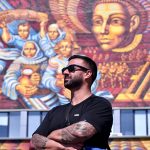When Jimmy Carter visited North Korea in 1994, it marked a pivotal moment in the history of U.S.-DPRK relations. As tensions over North Korea’s nuclear program reached a boiling point, Carter’s visit helped de-escalate a potential crisis and set the stage for future negotiations.
This article explores the context, key events, and anecdotes from the visit, offering a balanced look at its significance in diplomatic history.
The Context: Why Jimmy Carter Visited North Korea
In 1994, the Korean Peninsula teetered on the brink of conflict. North Korea’s nuclear ambitions had alarmed the international community, and the Clinton administration was weighing military options to address the escalating crisis. Amid this uncertainty, Jimmy Carter, former U.S. president and Nobel Peace Prize laureate, proposed a different approach: dialogue.
Though acting as a private citizen, Carter had tacit approval from Washington. His goal was to engage directly with North Korea’s leadership, emphasizing diplomacy over confrontation. The visit was a bold move, reflecting Carter’s enduring commitment to peaceful conflict resolution.
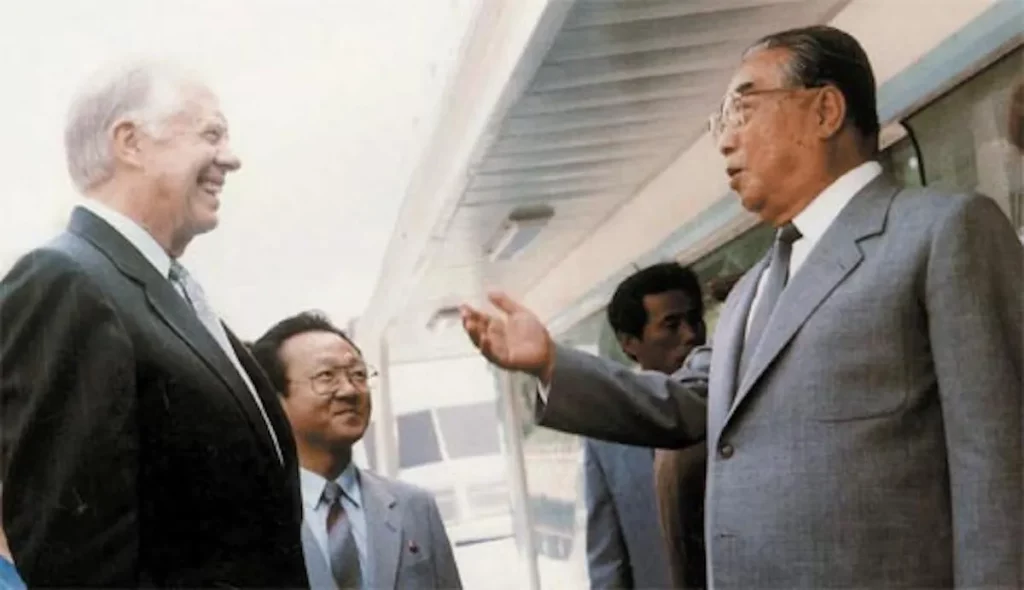
Former US President Jimmy Carter and North Korean leader Kim Il Sung talk during the former president’s 1994 trip to the communist country to discuss its nuclear arms program(Photo: JoongAng Ilbo)
Meeting Kim Il Sung
A defining moment of Carter’s visit was his meeting with Kim Il Sung, the founding leader of North Korea. This encounter was historic—it marked the first time a former U.S. president met with a North Korean leader.
Carter and Kim held extensive discussions at the Kumsusan Assembly Hall, focusing on the nuclear issue and broader peace prospects. According to Carter, Kim expressed a genuine desire for peace and reunification, presenting a vision for a stable Korean Peninsula.
North Korean accounts highlight Kim Il Sung’s magnanimity and Carter’s respect for the DPRK’s sovereignty. The meeting is often framed as an example of mutual understanding in North Korean narratives.
For more insights into U.S. presidents who have engaged with North Korea, check out this detailed overview
Key Outcomes: The Agreed Framework
Carter’s visit did not result in an immediate agreement, but it paved the way for the 1994 Agreed Framework. This accord saw North Korea commit to freezing its nuclear program in exchange for aid and the construction of light-water reactors.
The Agreed Framework was a rare instance of cooperation between the U.S. and DPRK, though it unraveled in the early 2000s. Nevertheless, Carter’s efforts are credited with averting an immediate crisis and creating a foundation for future dialogue.
Anecdotes from the Visit
When Jimmy Carter visited North Korea, his trip was marked by moments that offer a unique glimpse into the DPRK’s culture and leadership.
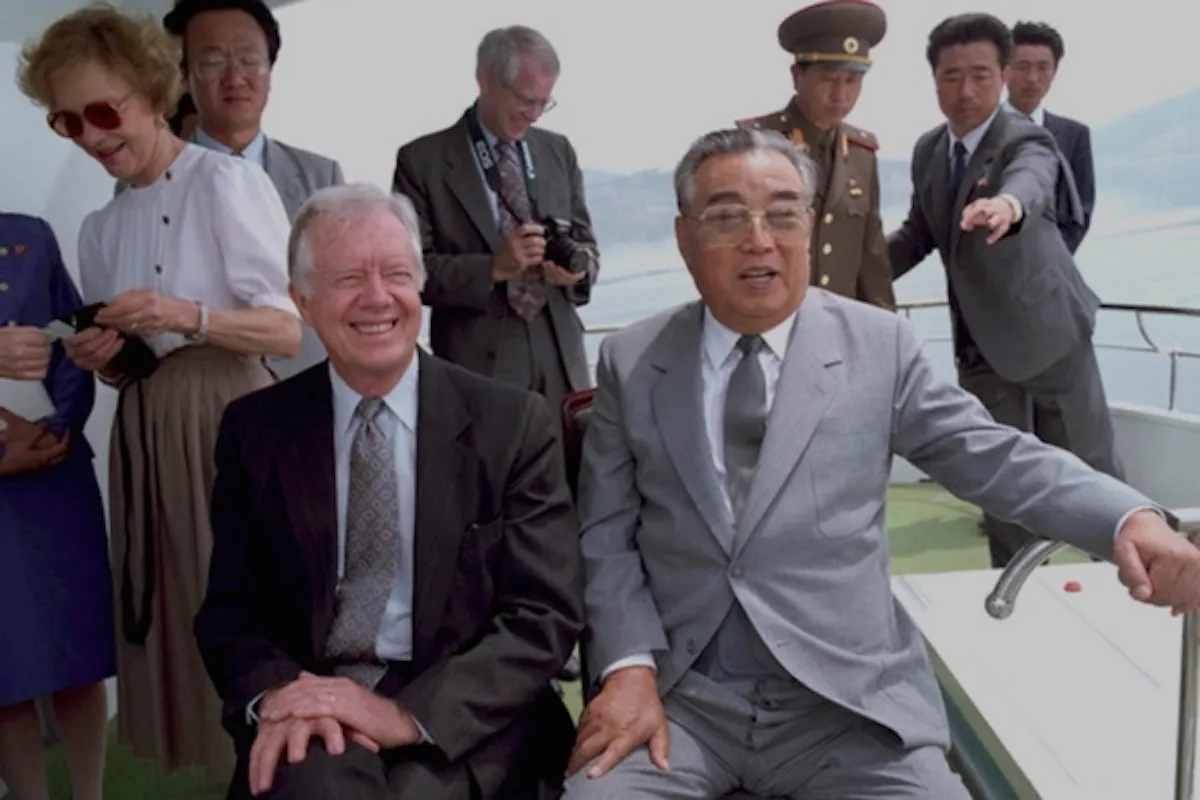
Former President Jimmy Carter and,. behind him, former First Lady Rosalynn Carter with Kim Il Sung aboard the North Korean leader’s yacht during their 1994 visit to Pyongyang(Photo: History News Network)
A Tour of Pyongyang
Carter was given a carefully curated tour of Pyongyang, including iconic landmarks such as the Arch of Triumph and the Mansudae Grand Monument. These visits were designed to showcase North Korea’s achievements and resilience.
Kim Il Sung’s Hospitality
North Korean sources often emphasize Kim Il Sung’s hospitality during Carter’s visit. Carter reportedly enjoyed a traditional Korean meal, accompanied by cultural performances, as a gesture of goodwill.
Rosalynn Carter’s Presence
Carter’s wife, Rosalynn, also played a role in the visit. Her interactions with local women and children added a personal dimension to the diplomatic mission, underscoring the human element in international relations.
North Korea’s Perspective on the Visit
In North Korea, Carter’s visit is remembered as a moment of mutual respect and understanding. State media emphasize Carter’s acknowledgment of Kim Il Sung’s leadership and the DPRK’s sovereignty.
For North Korea, the visit was also an opportunity to present itself as a nation committed to peace, despite ongoing tensions with the United States.
Visiting Sites Linked to the Visit
For those interested in the history of Jimmy Carter’s visit to North Korea, several sites in Pyongyang provide context and insight:
- Kumsusan Palace of the Sun: The mausoleum of Kim Il Sung and Kim Jong Il, where visitors can reflect on the DPRK’s leadership.
- Arch of Triumph: A symbol of North Korea’s resilience, visited by Carter during his trip.
- Mansudae Grand Monument: Iconic statues of Kim Il Sung and Kim Jong Il, representing the country’s revolutionary history.
If you’re curious about visiting North Korea and its historical landmarks, learn more about tours exploring the country’s history here.
Comparisons to Later U.S.-DPRK Engagements
Carter’s visit set a precedent for future interactions between U.S. leaders and North Korea. Decades later, the Trump-Kim summits would echo themes of dialogue and de-escalation. While the contexts differed, both instances highlighted the potential for diplomacy to address longstanding tensions.
For an in-depth look at the Trump-Kim meetings, see this analysis of the historic summits.
Conclusion: The Legacy of Jimmy Carter’s Visit
When Jimmy Carter visited North Korea in 1994, he demonstrated the power of diplomacy and dialogue. His efforts helped defuse a potentially catastrophic situation and laid the groundwork for future negotiations.
For North Korea, the visit remains a symbol of respect and recognition. For the United States, it serves as a reminder of the value of creative approaches to conflict resolution.
Carter’s visit offers valuable lessons for navigating U.S.-DPRK relations, emphasizing the importance of engagement over confrontation. As history continues to unfold on the Korean Peninsula, his legacy endures as a testament to the potential of diplomacy in resolving even the most entrenched conflicts.
Click the link for our DPRK Guide, as well as our Tours to North Korea,



